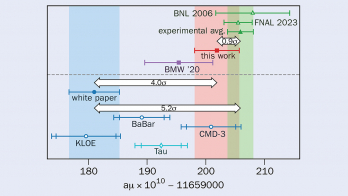By Dean Rickles
Springer
Hardback: £35.99 €32.12 $49.99
E-book: £27.99 €42.79 $39.99
Also available at the CERN bookshop

String theory provides a theoretical framework for unifying particle physics and gravity that is also consistent at the quantum level. Apart from particle physics, it also sheds light on a vast range of problems in physics and mathematics. For example, it helps in understanding certain properties of gauge theories, black holes, the early universe and even heavy-ion physics.
This new book fills a gap by reviewing the 40-year-plus history of the subject, which it divides into four parts, with the main focus on the earlier decades. The reader learns about the work of researchers in the early days in detail, where so-called dual models were investigated with the aim of describing hadron physics. It took ingenious insights to realize that the underlying physical interpretation is in terms of small, oscillating strings. Some of the groundbreaking work took place at CERN – for example, the discovery of the Veneziano amplitude.
The reader obtains a good impression of how it took many years of collective effort and struggle to develop the theory and understand it better, often incrementally, although sometimes the direction of research changed drastically in a serendipitous manner. For example, at some point there was an unexpected shift of interpretation, namely in terms of gravity rather than hadron physics. Supersymmetry was discovered along the way as well, demonstrating that string theory has been the source and inspiration of many ideas in particle physics, gravity and related fields.
The main strength of the book is the extensively and carefully researched history of string theory, rather than profound explanations of the physics (for which enough books are available). It is full of anecdotes, quotations of physicists at the time, and historical facts, to an extent that makes it unique. Despite the author’s avoidance of technicalities, the book seems to be more suitable for people educated in particle physics, and less suitable for philosophers, historians and other non-experts.
One caveat, however: the history covered in the book more or less stops at around the mid-1990s, and as the author emphasizes, the subject becomes much harder to describe after that, without going into the details more deeply. While some of the new and important developments are mentioned briefly in the last chapter – for example, the gauge/gravity correspondence – they do not get the attention that they deserve in relation to older parts of the history. In other words, while the history has been quite accurately presented until the mid-1990s, the significance of some of its earlier parts is rather overrated in comparison with more recent developments.
In summary, this is a worthwhile and enjoyable book, full of interesting details about the development of one of the main research areas of theoretical physics. It appears to be most useful to scientists educated in related fields, and I would even say that it should be a mandatory read for young colleagues entering research in string theory.








